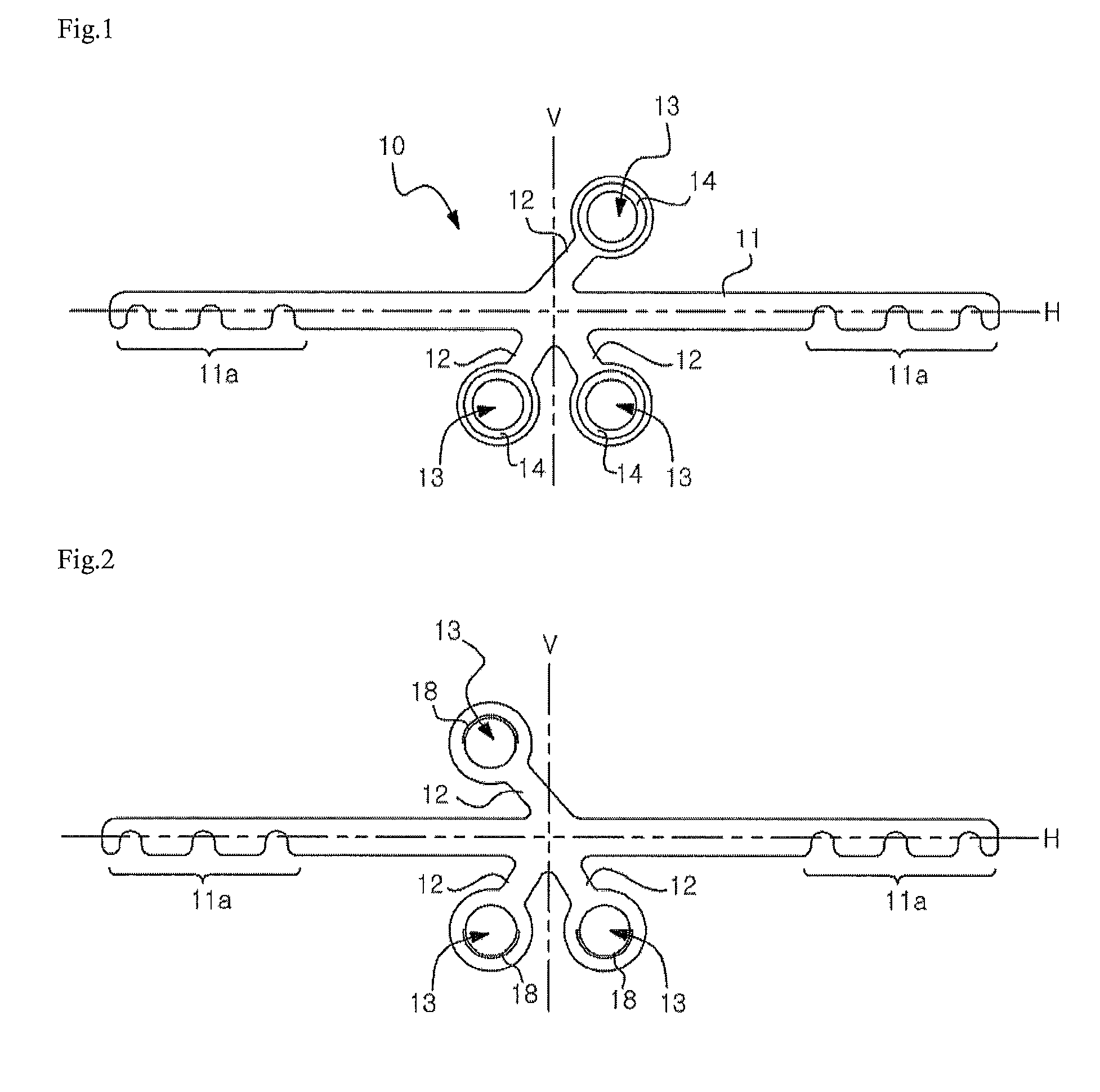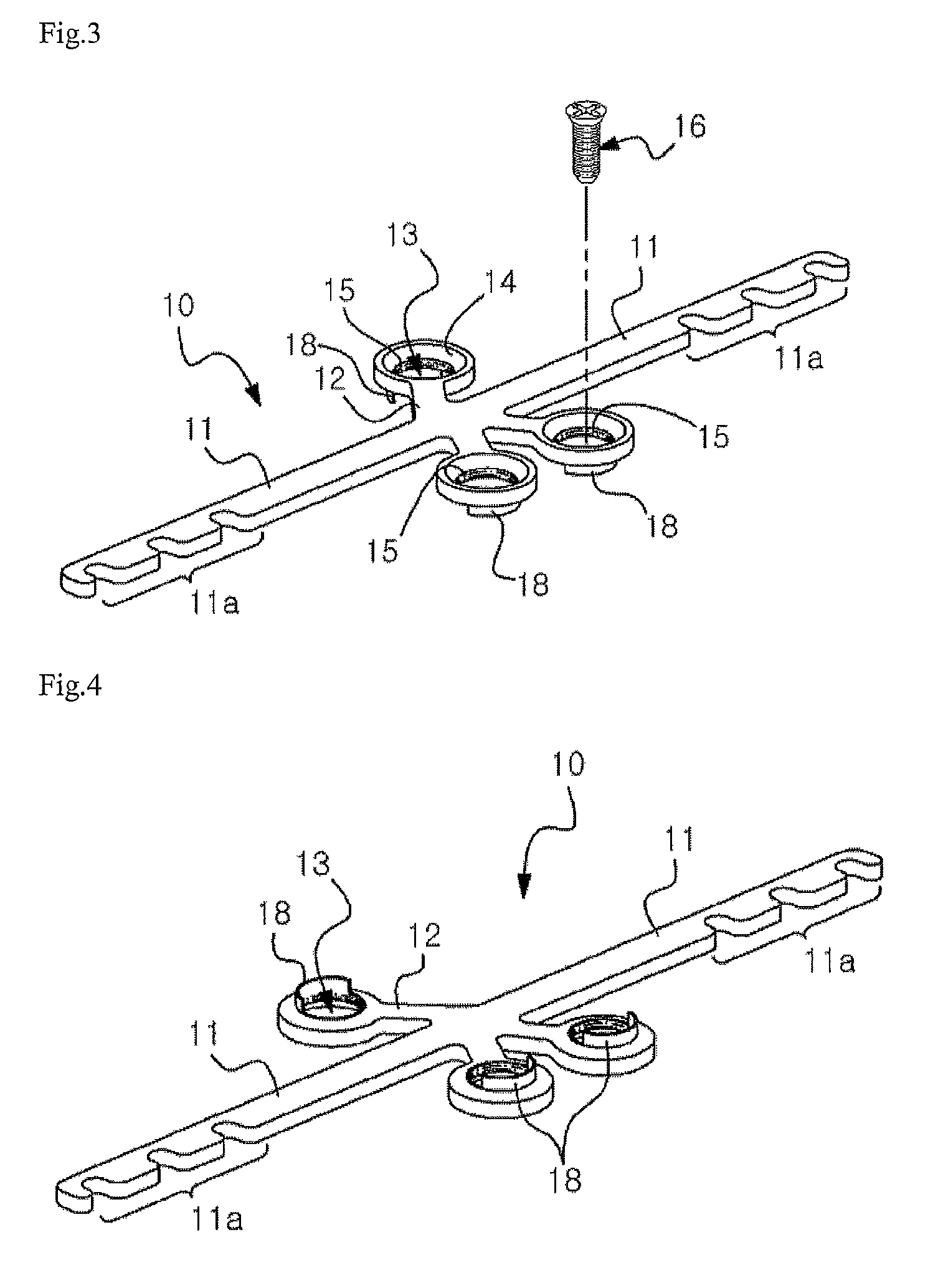Orthodontic supporting member
a support member and orthodontic technology, applied in dental surgery, dental tools, medical science, etc., can solve the problems of difficult to accurately adjust the position of the mini-implant, damage to the roots of the teeth, and difficulty in treating the teeth
- Summary
- Abstract
- Description
- Claims
- Application Information
AI Technical Summary
Benefits of technology
Problems solved by technology
Method used
Image
Examples
first exemplary embodiment
[0022
[0023]FIGS. 1 and 2 are respectively a top view and a bottom view of a support member 10 for correcting tooth irregularities, according to a first exemplary embodiment of the present invention. FIGS. 3 and 4 are respectively a top perspective view and a bottom perspective view of the support member 10 according to the first exemplary embodiment of the present invention.
[0024]The support member 10 according to the first exemplary embodiment includes a main body 11 that straightly extends and has hook portions 11a formed on both end portions thereof, and a plurality of leg portions 12 each of which extends from a central portion of the main body 11 and has a through-hole 13 formed in an end portion thereof.
[0025]Each of the leg portions 12 obliquely extends at a predetermined angle with respect to a second central line V perpendicular to a first central line H that extends in a longitudinal direction of the main body 11. Accordingly, as shown in FIGS. 1 and 2, the leg portions 12...
second exemplary embodiment
[0041
[0042]FIG. 6 is a top view of a support member 100 for correcting tooth irregularities, according to a second exemplary embodiment of the present invention. An overall structure of the support member 100, a process of providing the support member 100, and a function of the support member 100 of the present embodiment are the same as those of the support member 10 of FIGS. 1 through 4.
[0043]The support member 100 of the present exemplary embodiment is characterized in that a hook portion 110a is formed on an end portion of a main body 110, and a plurality of leg portions 120 radially extend on another end portion of the main body 110.
[0044]Each of the leg portions 120 obliquely extends at a predetermined angle with respect to the second central line V perpendicular to the first central line H that extends in a longitudinal direction of the main body 110.
[0045]Unlike the support member 10 according to the first exemplary embodiment, the support member 100 of the present exemplary...
third exemplary embodiment
[0048
[0049]As shown in FIG. 5, the support member 10 or 100 may be used to correct tooth irregularities by applying an external force to the molars T toward the throat. However, in order to apply an external force to the molars T in an opposite direction, that is, toward lips, the wire W that connects the fixtures 20 mounted on the molars T has to be disposed on a portion around the throat instead of the lips.
[0050]Also, an elastic force of the elastic body B may be applied to the fixtures 20 only when there is a sufficient distance between the wire W that connects the fixtures 20 and the hook portion 11a or 110a of the support member 10 or 100.
[0051]To this end, the support member 10 or 100 may be fixed to a portion of the palatine bone close to the lips instead of the throat. However, since a width of an area close to the lips is less than a width of an area close to the throat due to a structure of the oral cavity, it is not preferable to use the support member 10 according to th...
PUM
 Login to View More
Login to View More Abstract
Description
Claims
Application Information
 Login to View More
Login to View More - R&D
- Intellectual Property
- Life Sciences
- Materials
- Tech Scout
- Unparalleled Data Quality
- Higher Quality Content
- 60% Fewer Hallucinations
Browse by: Latest US Patents, China's latest patents, Technical Efficacy Thesaurus, Application Domain, Technology Topic, Popular Technical Reports.
© 2025 PatSnap. All rights reserved.Legal|Privacy policy|Modern Slavery Act Transparency Statement|Sitemap|About US| Contact US: help@patsnap.com



